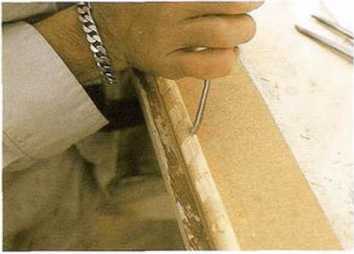essentÊrving°60

ESSENTIA.L w o O D C a R v I N G T E C H X I Q V E S

FlG 4.15 Cutting the side of the twist oftbe Å„bbon down co che ground with a No. 7 gouge. This acts as a stop aa.

FlG 4.16 The edge ofthe Å„bbon at the near side of the interval has been stabbed in down to the ground. The side of the stick has been stabbed down. No w the No. 7 gouge picks up the linÄ™ on top of the Å„bbon at the far side of the intewal and is stabbed in towards the side ofthe stick. The chisel should slope downwards when making this eta. It is slid around to stop against the back of the next twist ofthe Å„bbon.
stabbed in with the straight-edge. Next, the gouge is started in at a flatter angle from the cxposed edge oF ribbon ar rhe other side of the interval, so that the lowest part of its cut is in rhe middle of rhe inrerval and irs edge ascends to meet rhe descending edge of the ribbon (Fig 4.16). If its end is rounded the tool easily meers the side of the stick, but if the end is squarc you will necd to slide the corner of the chisel along the side of the stick to slice the fibres. If it has gone in far enough the seraight-edge stabbed down against the side of the stick should pop out of the wood cleanly. The finał stage is ro cut rhe side of rhe ribbon where it goes up under the descending twist, stabbing down with the fishtail or cutting from the side with a skew chisel. Try to align the cut so that it matchcs the same cut on the opposite side of the ribbon. A very sharp, narrow fluter is needcd to make the spiral grooves on the ribbon. (See Fig 4.1 for examples of completed ribbon and stick.)
Water Leaf
The ogee secrion moulding or cyma requires the following chisels.
♦ No. 5, 12mm (*/6in) or morc;
♦ No. 8 or 9, 4mm or 5mm (Móin);
♦ No. 8 or 7, 12mm ('/zin) or morc;
♦ No. 2 (Swiss), 3, 4 or 5, 20mm (3A'm).
Thcsc sizes will fit a moulding abour 19mm (3A\Å„) or 25mm (lin) wide. I describe here howrounded ends help some gouges to perform well.
The patterns again vary enormously (Fig 4.17), though most have a basically simple form which can be developed and enriched.
The curs may be donc in a varietv of sequcnces. The edge of the leaf can be weakened by the shaping of its surface, so it may be safer ro cut the dart first. The top of the dart is marked by a stab with the No. 8 or 9. If the gouge is rotated slightly
_60 _
Wyszukiwarka
Podobne podstrony:
essent?rving?68 Essen tial Woodcarving Techniques FlG 15.16 The fint cut into the serif on an M. Fig
91 3 # APF-91 p. 02 11. Pin the bodice front and back co che slecvc aacchine A*a and 3*5 Pin and scu
essent?rving?70 Es S E N TI A L W O O D C A R VING TeCHXIQUE$ Fig 15.23 The fishtail cutting the end
essent?rving?62 E S S E N T I A L W O O D C A R v I N G T F. C H N I Q U E S FlG 4.18 The edges of t
essent?rving?63 C A R V E D M O U L D I N G S FlG 4.20 A finishedpractice section of moulding. The s
essent?rving?64 Essential W o o d c a r V in g T e c h niqie s Fic 4.23 A large No. 5gouge shaping t
essent?rving?81 FlG 7.2 An example of lute, debased, linenfoldfrom a Welsb church. The colour was us
essent?rving?87 L I N F. N F O I. D Fig 7.13 Cutting along the top of the lower fołd.COLOUR AND FlNI
essent?rving?95 - C A R V I N G A COMMONPLACE OBJECT IN H I G H R; : .H Fig 8.15 Texturing the insid
essent?rving?37 C A R V ! N G T H F. H t M A N F I G l R F. FlG 12.20 Thepine and tualtiut heads fro
essent?rving?54 FlG 14.10 A sculpture on the theme of Compression in cedar of Lebanon by Zena Micha
essent?rving?47 First C i t s: Chip C a r v i n c, Fig 3.3 The depth of the stab cut. exercise. Cut
essent?rving?12 E S S F. N T I A I. W O O r> C A R V I N G T E C H X I Q V E S Fic 10.12 The arra
essent?rving?21 C A R V 1 N G A N Ani M AL IN THE R O l N D Fig 11.5 Rear view. The saw cnts facilit
essent?rving?56 CHAPTER 15INCISEDLETTERING Lettering is Part of the Message £ T f BRIX don’c spell b
$(KGrHqJ,!r!F! HEed(zBQi(7P8EVw~~60W Clutch Lever The double pedał on the right side of the motor ia
00151 ?ac5d664405d180127a449f8d3c8023 152 Simpson & Keats values of the ARLs. Table 15 shows th
więcej podobnych podstron